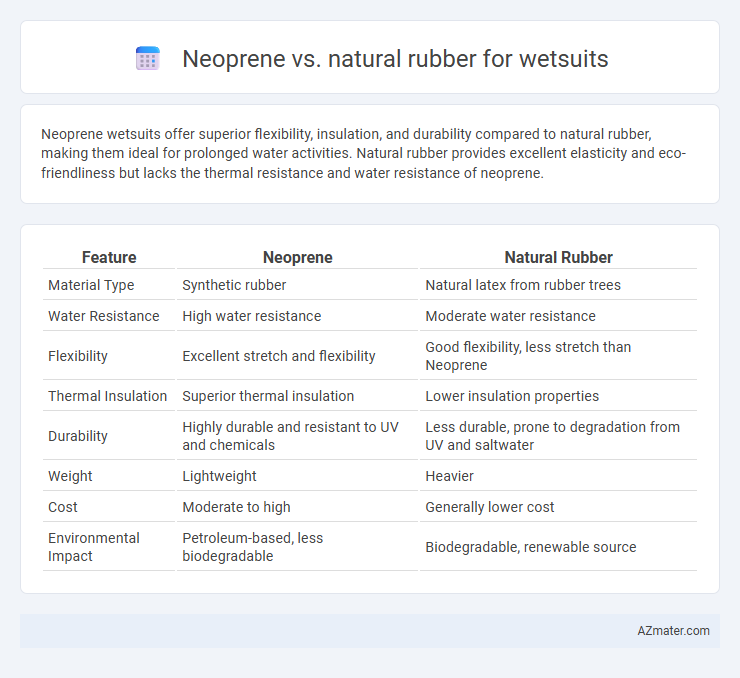Neoprene wetsuits offer superior flexibility, insulation, and durability compared to natural rubber, making them ideal for prolonged water activities. Natural rubber provides excellent elasticity and eco-friendliness but lacks the thermal resistance and water resistance of neoprene.
Table of Comparison
| Feature | Neoprene | Natural Rubber |
|---|---|---|
| Material Type | Synthetic rubber | Natural latex from rubber trees |
| Water Resistance | High water resistance | Moderate water resistance |
| Flexibility | Excellent stretch and flexibility | Good flexibility, less stretch than Neoprene |
| Thermal Insulation | Superior thermal insulation | Lower insulation properties |
| Durability | Highly durable and resistant to UV and chemicals | Less durable, prone to degradation from UV and saltwater |
| Weight | Lightweight | Heavier |
| Cost | Moderate to high | Generally lower cost |
| Environmental Impact | Petroleum-based, less biodegradable | Biodegradable, renewable source |
Introduction to Wetsuit Materials
Wetsuit materials primarily consist of neoprene and natural rubber, each offering distinct properties for thermal insulation and flexibility in aquatic environments. Neoprene, a synthetic rubber, provides superior durability, water resistance, and insulation compared to natural rubber, making it the preferred choice for modern wetsuits. Natural rubber offers excellent elasticity and biodegradability but is less resistant to environmental factors, impacting its longevity and performance in wetsuit applications.
What is Neoprene?
Neoprene is a synthetic rubber widely used in wetsuits because of its excellent insulation properties, flexibility, and resistance to water, oil, and heat. Unlike natural rubber, neoprene maintains durability and performance in cold and wet conditions due to its closed-cell foam structure, which traps air and provides thermal insulation. This makes neoprene the preferred material for wetsuits, offering superior comfort and protection for water sports enthusiasts.
What is Natural Rubber?
Natural rubber, derived from the latex sap of rubber trees (Hevea brasiliensis), offers high elasticity, resilience, and water resistance, making it a traditional material for wetsuit construction. Unlike synthetic neoprene, natural rubber provides superior environmental biodegradability and excellent thermal insulation properties. However, neoprene often surpasses natural rubber in flexibility, durability, and resistance to ozone and UV degradation, which are critical factors for prolonged wetsuit performance.
Manufacturing Processes Compared
Neoprene wetsuits are produced through a synthetic process involving polymerization of chloroprene, creating a closed-cell foam that offers excellent insulation and flexibility. Natural rubber wetsuits rely on latex harvested from rubber trees, which undergoes vulcanization to enhance elasticity and durability. The synthetic manufacturing of neoprene allows for more uniform production and consistent material properties compared to the more variable natural rubber processing.
Stretch and Flexibility Differences
Neoprene offers superior stretch and flexibility compared to natural rubber, making it ideal for wetsuits that require a close fit and unrestricted movement. Its closed-cell structure allows for greater elasticity and rebound, enhancing comfort and performance during dynamic water activities. Natural rubber, while flexible, is less resistant to water and UV exposure, leading to reduced elasticity over time and decreased durability in marine environments.
Thermal Insulation Properties
Neoprene offers superior thermal insulation for wetsuits due to its closed-cell foam structure that traps heat and reduces water absorption, maintaining warmth in cold water conditions. Natural rubber, while flexible, has an open-cell structure that allows more water penetration, leading to faster heat loss and reduced thermal efficiency. The enhanced insulation properties of neoprene make it the preferred material for high-performance wetsuits in diverse aquatic environments.
Environmental Impact and Sustainability
Neoprene wetsuits, made from synthetic polymers derived from petroleum, have a higher environmental footprint due to energy-intensive production and limited biodegradability. Natural rubber, sourced from rubber trees, offers a more sustainable alternative with renewable origins and faster decomposition, reducing long-term landfill impact. However, sustainable practices in farming and processing natural rubber are crucial to minimize deforestation and carbon emissions.
Durability and Longevity
Neoprene wetsuits offer superior durability and longevity compared to natural rubber due to their enhanced resistance to UV rays, ozone, and chemical degradation. Natural rubber tends to degrade faster when exposed to environmental stressors, leading to cracks and reduced elasticity over time. Neoprene's synthetic composition ensures prolonged flexibility and sustained performance in harsh water conditions.
Price and Availability
Neoprene wetsuits tend to be more expensive than those made from natural rubber due to their synthetic production process and high demand in the diving industry. Natural rubber wetsuits are generally more affordable but less widely available, as their use has declined in favor of neoprene's superior insulation and durability. Availability of neoprene wetsuits is high globally, supported by large-scale manufacturing, while natural rubber wetsuits are often limited to niche or eco-friendly markets.
Which Material is Best for Your Wetsuit?
Neoprene is the most popular material for wetsuits due to its superior insulation, flexibility, and durability compared to natural rubber, which tends to degrade faster and offers less thermal protection. Neoprene's closed-cell structure traps air, providing excellent buoyancy and warmth, making it ideal for prolonged water exposure. Natural rubber wetsuits may be more eco-friendly but generally lack the performance characteristics needed for cold water or extended use.

Infographic: Neoprene vs Natural rubber for Wetsuit
 azmater.com
azmater.com